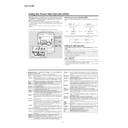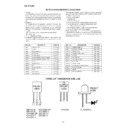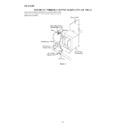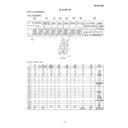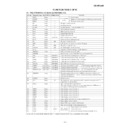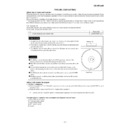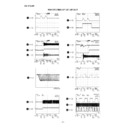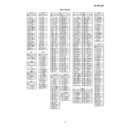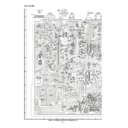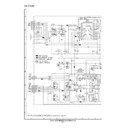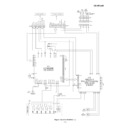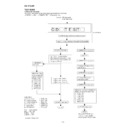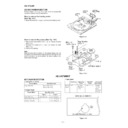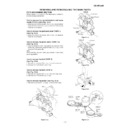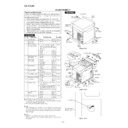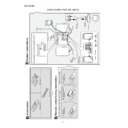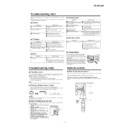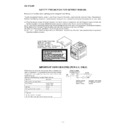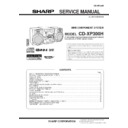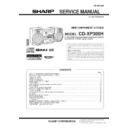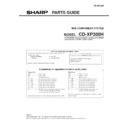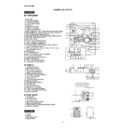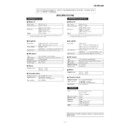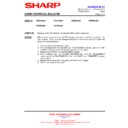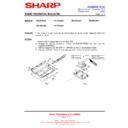Sharp CD-XP300 (serv.man5) Service Manual ▷ View online
CD-XP300H
– 6 –
Using the Radio Data System (RDS)
RDS is a broadcasting service which a growing number of FM stations provide.
These FM stations send additional signals along with their regular programme
signals. They send their station names, and information about the type of pro-
gramme such as sports or music, etc.
When tuned to an RDS station, "RDS" and the station name will be displayed.
"TP" (Traffic Programme) will appear on the display when the received broadcast car-
ries traffic information, and "TA" (Traffic Announcement) will appear whilst a traffic
information is on air.
"PTYI" (Dynamic PTY Indicator) will appear whilst the Dynamic PTY station is
received.
You can control the RDS by using the buttons on the main unit only.
These FM stations send additional signals along with their regular programme
signals. They send their station names, and information about the type of pro-
gramme such as sports or music, etc.
When tuned to an RDS station, "RDS" and the station name will be displayed.
"TP" (Traffic Programme) will appear on the display when the received broadcast car-
ries traffic information, and "TA" (Traffic Announcement) will appear whilst a traffic
information is on air.
"PTYI" (Dynamic PTY Indicator) will appear whilst the Dynamic PTY station is
received.
You can control the RDS by using the buttons on the main unit only.
Information provided by RDS
Each time the DISPLAY MODE button is pressed, the display will switch as fol-
lows:
lows:
When you are tuning in to a station other than an RDS station or to an RDS station
which sends weak signal, the display will change in the following order:
Notes for RDS operation
If any of the following events occur, it does not mean that the unit is
faulty:
faulty:
"PS", "NO PS" and a station name appear alternately, and the unit does not oper-
ate properly.
If a particular station is not broadcasting properly or a station is conducting tests,
the RDS reception function may not work properly.
When you receive an RDS station whose signal it too weak, information like the
station name may not be displayed.
"NO PS", "NO PTY" or "NO RT" will flash for about 5 seconds, and then the fre-
quency will be displayed.
ate properly.
If a particular station is not broadcasting properly or a station is conducting tests,
the RDS reception function may not work properly.
When you receive an RDS station whose signal it too weak, information like the
station name may not be displayed.
"NO PS", "NO PTY" or "NO RT" will flash for about 5 seconds, and then the fre-
quency will be displayed.
Notes for radio text:
The first 8 characters of the radio text will appear for 4 seconds and then they will
scroll across the display.
If you tune in to an RDS station which is not broadcasting any radio text, "NO RT"
will be displayed when you switch to the radio text position.
Whilst radio text data is received or when the text contents change, "RT" will be
displayed.
scroll across the display.
If you tune in to an RDS station which is not broadcasting any radio text, "NO RT"
will be displayed when you switch to the radio text position.
Whilst radio text data is received or when the text contents change, "RT" will be
displayed.
Station name (PS)
Programme type (PTY)
Frequency
Radio text (RT)
NO PS
NO PTY
FM 98.80 MHz
NO RT
Descriptions of the PTY (Programme Type) codes, TP (Traffic Programme) and
TA (Traffic Announcement).
You can search for and receive the following PTY, TP and TA signals.
TA (Traffic Announcement).
You can search for and receive the following PTY, TP and TA signals.
NEWS
Short accounts of facts, events and publicly expressed views, report-
age and actuality.
age and actuality.
AFFAIRS
Topical programme expanding or enlarging upon the news, generally
in different presentation style or concept, including debate, or analy-
sis.
in different presentation style or concept, including debate, or analy-
sis.
INFO
Programmes whose purpose is to impart advice in the widest sense.
SPORT
Programme concerned with any aspect of sport.
EDUCATE
Programme intended primarily to educate, of which the formal ele-
ment is fundamental.
ment is fundamental.
DRAMA
All radio plays and serials.
CULTURE
Programmes concerned with any aspect of national or regional cul-
ture, including language, theatre, etc.
ture, including language, theatre, etc.
SCIENCE
Programmes about the natural sciences and technology.
VARIED
Used for mainly speech-based programmes usually of light-entertain-
ment nature, not covered by other categories. Examples include:
quizzes, panel games, personality interviews.
ment nature, not covered by other categories. Examples include:
quizzes, panel games, personality interviews.
POP M
Commercial music, which would generally be considered to be of cur-
rent popular appeal, often featuring in current or recent record sales
charts.
rent popular appeal, often featuring in current or recent record sales
charts.
ROCK M
EASY M
Current contemporary music considered to be "easy-listening", as op-
posed to Pop, Rock or Classical, or one of the specialised music
styles, Jazz, Folk or Country. Music in this category is often but not
always, vocal, and usually of short duration.
posed to Pop, Rock or Classical, or one of the specialised music
styles, Jazz, Folk or Country. Music in this category is often but not
always, vocal, and usually of short duration.
LIGHT M
Classical music for general, rather than specialist appreciation. Ex-
amples of music in this category are instrumental music, and vocal or
choral works.
amples of music in this category are instrumental music, and vocal or
choral works.
CLASSICS
Performances of major orchestral works, symphonies, chamber mu-
sic, etc., and including Grand Opera.
sic, etc., and including Grand Opera.
OTHER M
Musical styles not fitting into any of the other categories. Particularly
used for specialist music of which Rhythm & Blues and Reggae are
examples.
used for specialist music of which Rhythm & Blues and Reggae are
examples.
WEATHER
Weather reports and forecasts and meteorological information.
FINANCE
Stock Market reports, commerce, trading, etc.
CHILDREN
For programmes targeted at a young audience, primarily for entertain-
ment and interest, rather than where the objective is to educate.
ment and interest, rather than where the objective is to educate.
SOCIAL
Programmes about people and things that influence them individually
or in groups. Includes: sociology, history, geography, psychology and
society.
or in groups. Includes: sociology, history, geography, psychology and
society.
RELIGION
Any aspect of beliefs and faiths, involving a God or Gods, the nature
of existence and ethics.
of existence and ethics.
PHONE IN
Involving members of the public expressing their views either by
phone or at a public forum.
phone or at a public forum.
TRAVEL
Features and programmes concerned with travel to near and far des-
tinations, package tours and travel ideas and opportunities. Not for
use for announcements about problems, delays, or roadworks affect-
ing immediate travel where TP/TA should be used.
tinations, package tours and travel ideas and opportunities. Not for
use for announcements about problems, delays, or roadworks affect-
ing immediate travel where TP/TA should be used.
LEISURE
Programmes concerned with recreational activities in which the listen-
er might participate. Examples include, Gardening, Fishing, Antique
collecting, Cooking, Food & Wine, etc.
er might participate. Examples include, Gardening, Fishing, Antique
collecting, Cooking, Food & Wine, etc.
JAZZ
Polyphonic, syncopated music characterised by improvisation.
COUNTRY
Songs which originate from, or continue the musical tradition of the
American Southern States. Characterised by a straightforward melo-
dy and narrative story line.
American Southern States. Characterised by a straightforward melo-
dy and narrative story line.
NATION M
Current Popular Music of the Nation or Region in that country's lan-
guage, as opposed to International 'Pop' which is usually US or UK
inspired and in English.
guage, as opposed to International 'Pop' which is usually US or UK
inspired and in English.
OLDIES
Music from the so-called "golden age" of popular music.
FOLK M
Music which has its roots in the musical culture of a particular nation,
usually played on acoustic instruments. The narrative or story may be
based on historical events or people.
usually played on acoustic instruments. The narrative or story may be
based on historical events or people.
DOCU-
MENT
MENT
Programme concerned with factual matters, presented in an investi-
gative style.
gative style.
TEST
Broadcast when testing emergency broadcast equipment or receiv-
ers.
ers.
ALARM !
Emergency announcement made under exceptional circumstances to
give warning of events causing danger of a general nature.
give warning of events causing danger of a general nature.
NONE
No programme type (receive only).
TP
Broadcasts which carry traffic announcements.
TA
Traffic announcements are being broadcast.
Display

